FIN620 - Ford Motor Company's Value Enhancement Plan Analysis
VerifiedAdded on 2023/04/21
|7
|1909
|387
Case Study
AI Summary
This case study examines Ford Motor Company's Value Enhancement Plan (VEP) initiated to address its declining share price despite substantial cash reserves. The plan aimed to restructure capital and enhance shareholder value by distributing excess cash. The analysis covers the issues surrounding the plan, including shareholder opposition to changes in the ownership structure that favored the Ford family's control. The VEP's benefits for the company, shareholders, and the Ford family are discussed, highlighting the strategy's potential to improve Ford's market capitalization and demonstrate its financial stability. The case also explores the implications of holding excessive cash reserves and the importance of effective capital allocation. Ultimately, the VEP aimed to resolve the undervaluation of Ford's shares and allow shareholders to benefit from the company's financial strength.
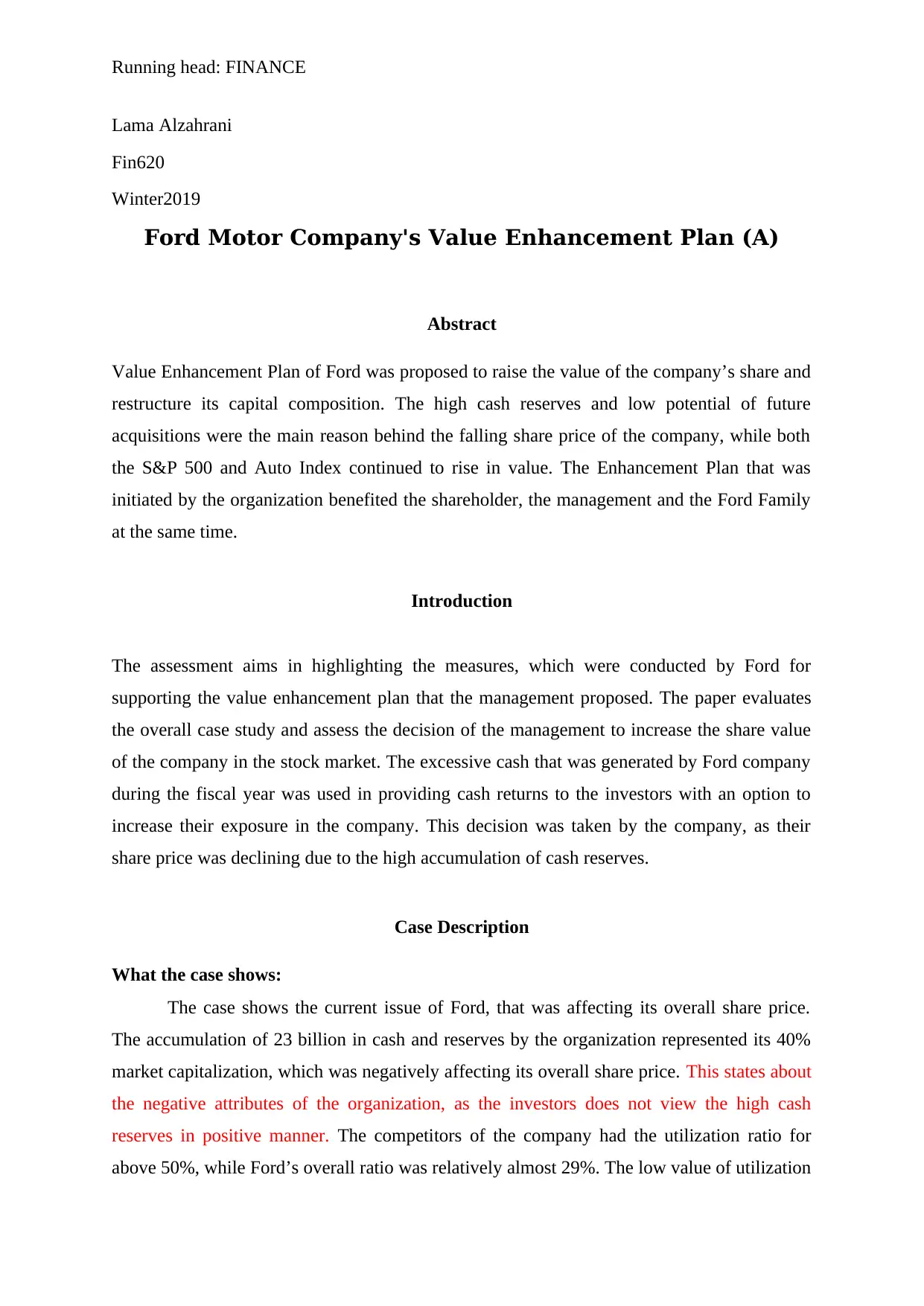
Running head: FINANCE
Lama Alzahrani
Fin620
Winter2019
Ford Motor Company's Value Enhancement Plan (A)
Abstract
Value Enhancement Plan of Ford was proposed to raise the value of the company’s share and
restructure its capital composition. The high cash reserves and low potential of future
acquisitions were the main reason behind the falling share price of the company, while both
the S&P 500 and Auto Index continued to rise in value. The Enhancement Plan that was
initiated by the organization benefited the shareholder, the management and the Ford Family
at the same time.
Introduction
The assessment aims in highlighting the measures, which were conducted by Ford for
supporting the value enhancement plan that the management proposed. The paper evaluates
the overall case study and assess the decision of the management to increase the share value
of the company in the stock market. The excessive cash that was generated by Ford company
during the fiscal year was used in providing cash returns to the investors with an option to
increase their exposure in the company. This decision was taken by the company, as their
share price was declining due to the high accumulation of cash reserves.
Case Description
What the case shows:
The case shows the current issue of Ford, that was affecting its overall share price.
The accumulation of 23 billion in cash and reserves by the organization represented its 40%
market capitalization, which was negatively affecting its overall share price. This states about
the negative attributes of the organization, as the investors does not view the high cash
reserves in positive manner. The competitors of the company had the utilization ratio for
above 50%, while Ford’s overall ratio was relatively almost 29%. The low value of utilization
Lama Alzahrani
Fin620
Winter2019
Ford Motor Company's Value Enhancement Plan (A)
Abstract
Value Enhancement Plan of Ford was proposed to raise the value of the company’s share and
restructure its capital composition. The high cash reserves and low potential of future
acquisitions were the main reason behind the falling share price of the company, while both
the S&P 500 and Auto Index continued to rise in value. The Enhancement Plan that was
initiated by the organization benefited the shareholder, the management and the Ford Family
at the same time.
Introduction
The assessment aims in highlighting the measures, which were conducted by Ford for
supporting the value enhancement plan that the management proposed. The paper evaluates
the overall case study and assess the decision of the management to increase the share value
of the company in the stock market. The excessive cash that was generated by Ford company
during the fiscal year was used in providing cash returns to the investors with an option to
increase their exposure in the company. This decision was taken by the company, as their
share price was declining due to the high accumulation of cash reserves.
Case Description
What the case shows:
The case shows the current issue of Ford, that was affecting its overall share price.
The accumulation of 23 billion in cash and reserves by the organization represented its 40%
market capitalization, which was negatively affecting its overall share price. This states about
the negative attributes of the organization, as the investors does not view the high cash
reserves in positive manner. The competitors of the company had the utilization ratio for
above 50%, while Ford’s overall ratio was relatively almost 29%. The low value of utilization
Paraphrase This Document
Need a fresh take? Get an instant paraphrase of this document with our AI Paraphraser
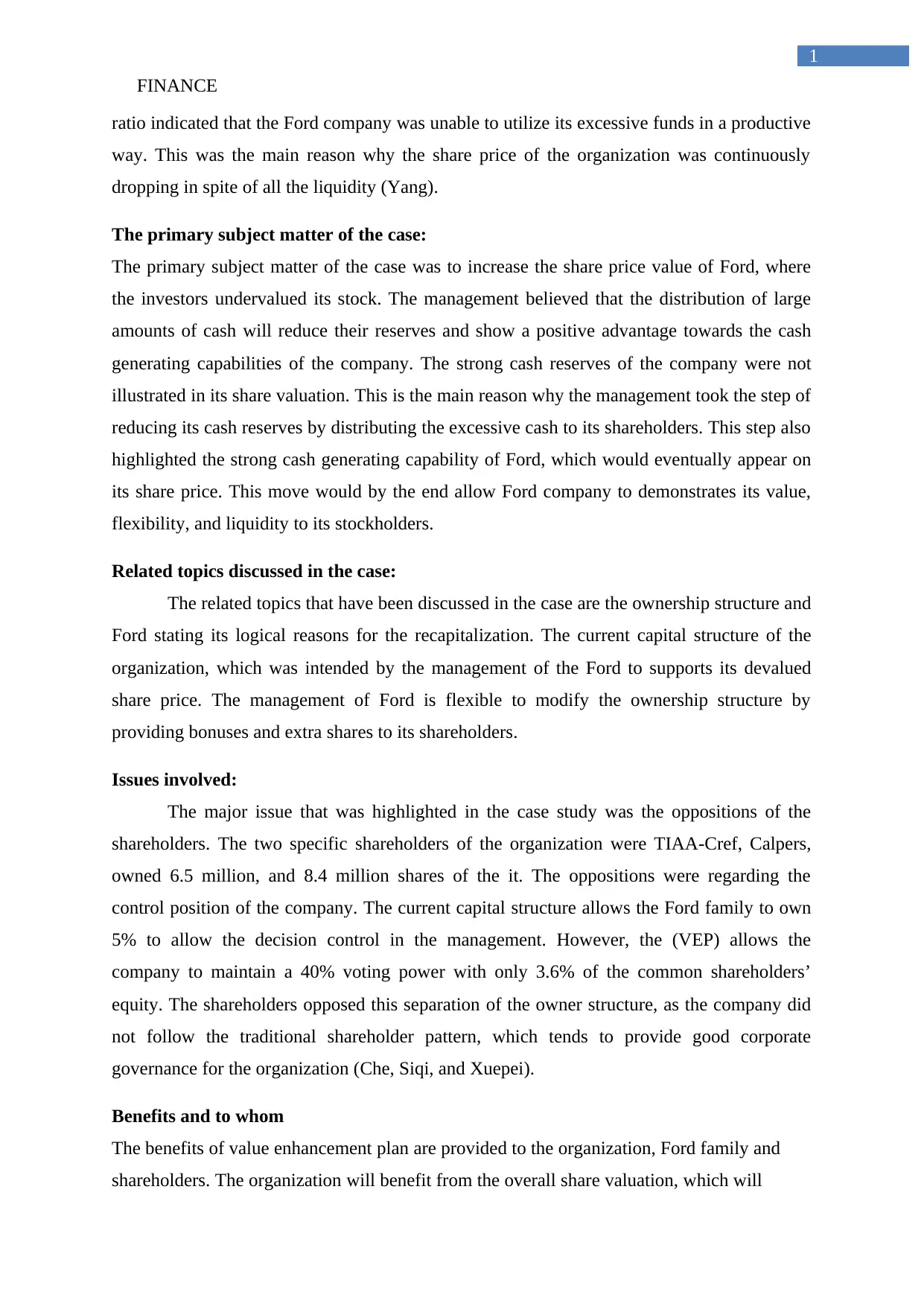
FINANCE
1
ratio indicated that the Ford company was unable to utilize its excessive funds in a productive
way. This was the main reason why the share price of the organization was continuously
dropping in spite of all the liquidity (Yang).
The primary subject matter of the case:
The primary subject matter of the case was to increase the share price value of Ford, where
the investors undervalued its stock. The management believed that the distribution of large
amounts of cash will reduce their reserves and show a positive advantage towards the cash
generating capabilities of the company. The strong cash reserves of the company were not
illustrated in its share valuation. This is the main reason why the management took the step of
reducing its cash reserves by distributing the excessive cash to its shareholders. This step also
highlighted the strong cash generating capability of Ford, which would eventually appear on
its share price. This move would by the end allow Ford company to demonstrates its value,
flexibility, and liquidity to its stockholders.
Related topics discussed in the case:
The related topics that have been discussed in the case are the ownership structure and
Ford stating its logical reasons for the recapitalization. The current capital structure of the
organization, which was intended by the management of the Ford to supports its devalued
share price. The management of Ford is flexible to modify the ownership structure by
providing bonuses and extra shares to its shareholders.
Issues involved:
The major issue that was highlighted in the case study was the oppositions of the
shareholders. The two specific shareholders of the organization were TIAA-Cref, Calpers,
owned 6.5 million, and 8.4 million shares of the it. The oppositions were regarding the
control position of the company. The current capital structure allows the Ford family to own
5% to allow the decision control in the management. However, the (VEP) allows the
company to maintain a 40% voting power with only 3.6% of the common shareholders’
equity. The shareholders opposed this separation of the owner structure, as the company did
not follow the traditional shareholder pattern, which tends to provide good corporate
governance for the organization (Che, Siqi, and Xuepei).
Benefits and to whom
The benefits of value enhancement plan are provided to the organization, Ford family and
shareholders. The organization will benefit from the overall share valuation, which will
1
ratio indicated that the Ford company was unable to utilize its excessive funds in a productive
way. This was the main reason why the share price of the organization was continuously
dropping in spite of all the liquidity (Yang).
The primary subject matter of the case:
The primary subject matter of the case was to increase the share price value of Ford, where
the investors undervalued its stock. The management believed that the distribution of large
amounts of cash will reduce their reserves and show a positive advantage towards the cash
generating capabilities of the company. The strong cash reserves of the company were not
illustrated in its share valuation. This is the main reason why the management took the step of
reducing its cash reserves by distributing the excessive cash to its shareholders. This step also
highlighted the strong cash generating capability of Ford, which would eventually appear on
its share price. This move would by the end allow Ford company to demonstrates its value,
flexibility, and liquidity to its stockholders.
Related topics discussed in the case:
The related topics that have been discussed in the case are the ownership structure and
Ford stating its logical reasons for the recapitalization. The current capital structure of the
organization, which was intended by the management of the Ford to supports its devalued
share price. The management of Ford is flexible to modify the ownership structure by
providing bonuses and extra shares to its shareholders.
Issues involved:
The major issue that was highlighted in the case study was the oppositions of the
shareholders. The two specific shareholders of the organization were TIAA-Cref, Calpers,
owned 6.5 million, and 8.4 million shares of the it. The oppositions were regarding the
control position of the company. The current capital structure allows the Ford family to own
5% to allow the decision control in the management. However, the (VEP) allows the
company to maintain a 40% voting power with only 3.6% of the common shareholders’
equity. The shareholders opposed this separation of the owner structure, as the company did
not follow the traditional shareholder pattern, which tends to provide good corporate
governance for the organization (Che, Siqi, and Xuepei).
Benefits and to whom
The benefits of value enhancement plan are provided to the organization, Ford family and
shareholders. The organization will benefit from the overall share valuation, which will
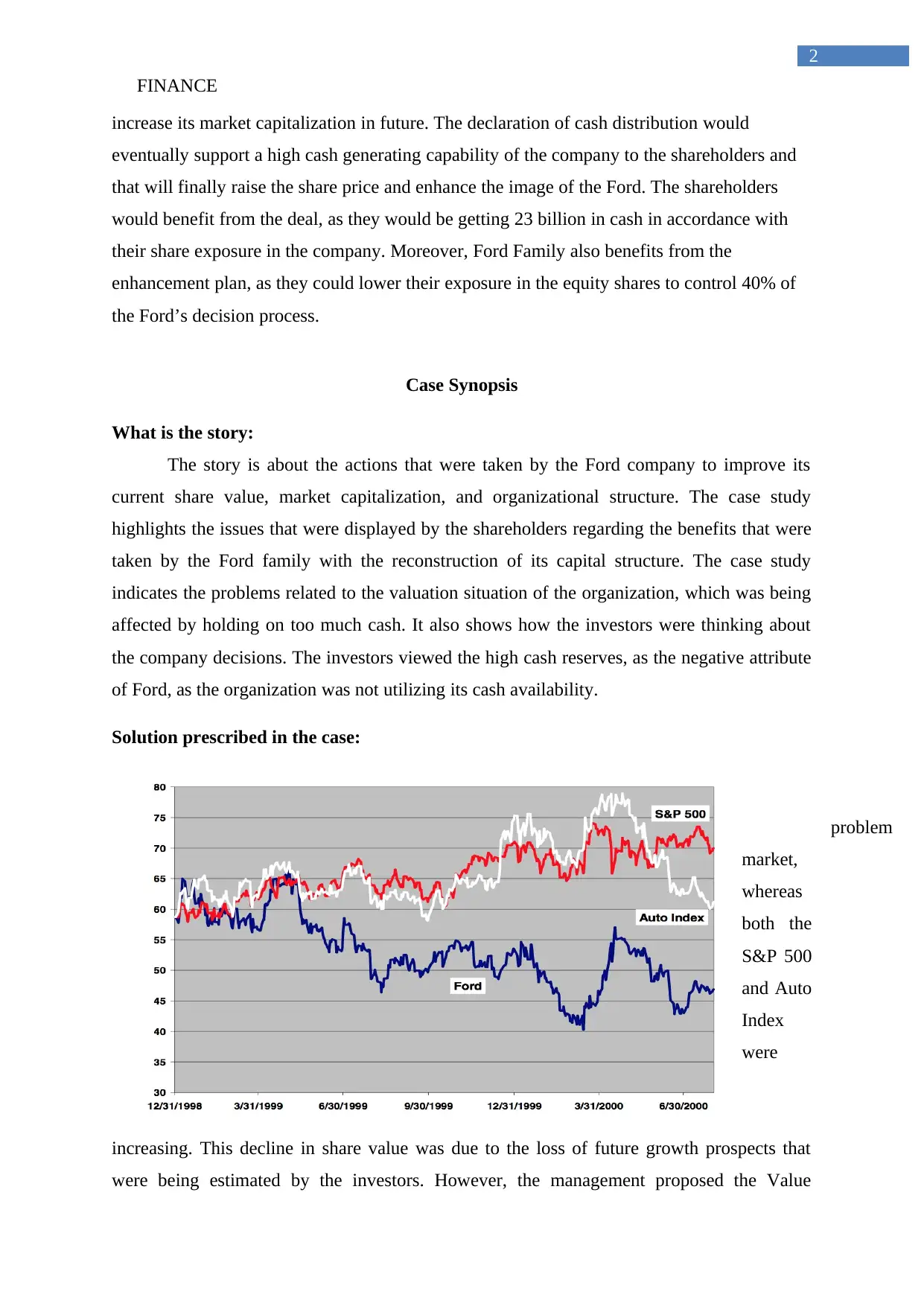
FINANCE
2
increase its market capitalization in future. The declaration of cash distribution would
eventually support a high cash generating capability of the company to the shareholders and
that will finally raise the share price and enhance the image of the Ford. The shareholders
would benefit from the deal, as they would be getting 23 billion in cash in accordance with
their share exposure in the company. Moreover, Ford Family also benefits from the
enhancement plan, as they could lower their exposure in the equity shares to control 40% of
the Ford’s decision process.
Case Synopsis
What is the story:
The story is about the actions that were taken by the Ford company to improve its
current share value, market capitalization, and organizational structure. The case study
highlights the issues that were displayed by the shareholders regarding the benefits that were
taken by the Ford family with the reconstruction of its capital structure. The case study
indicates the problems related to the valuation situation of the organization, which was being
affected by holding on too much cash. It also shows how the investors were thinking about
the company decisions. The investors viewed the high cash reserves, as the negative attribute
of Ford, as the organization was not utilizing its cash availability.
Solution prescribed in the case:
There was problem
market,
whereas
both the
S&P 500
and Auto
Index
were
increasing. This decline in share value was due to the loss of future growth prospects that
were being estimated by the investors. However, the management proposed the Value
2
increase its market capitalization in future. The declaration of cash distribution would
eventually support a high cash generating capability of the company to the shareholders and
that will finally raise the share price and enhance the image of the Ford. The shareholders
would benefit from the deal, as they would be getting 23 billion in cash in accordance with
their share exposure in the company. Moreover, Ford Family also benefits from the
enhancement plan, as they could lower their exposure in the equity shares to control 40% of
the Ford’s decision process.
Case Synopsis
What is the story:
The story is about the actions that were taken by the Ford company to improve its
current share value, market capitalization, and organizational structure. The case study
highlights the issues that were displayed by the shareholders regarding the benefits that were
taken by the Ford family with the reconstruction of its capital structure. The case study
indicates the problems related to the valuation situation of the organization, which was being
affected by holding on too much cash. It also shows how the investors were thinking about
the company decisions. The investors viewed the high cash reserves, as the negative attribute
of Ford, as the organization was not utilizing its cash availability.
Solution prescribed in the case:
There was problem
market,
whereas
both the
S&P 500
and Auto
Index
were
increasing. This decline in share value was due to the loss of future growth prospects that
were being estimated by the investors. However, the management proposed the Value
⊘ This is a preview!⊘
Do you want full access?
Subscribe today to unlock all pages.

Trusted by 1+ million students worldwide
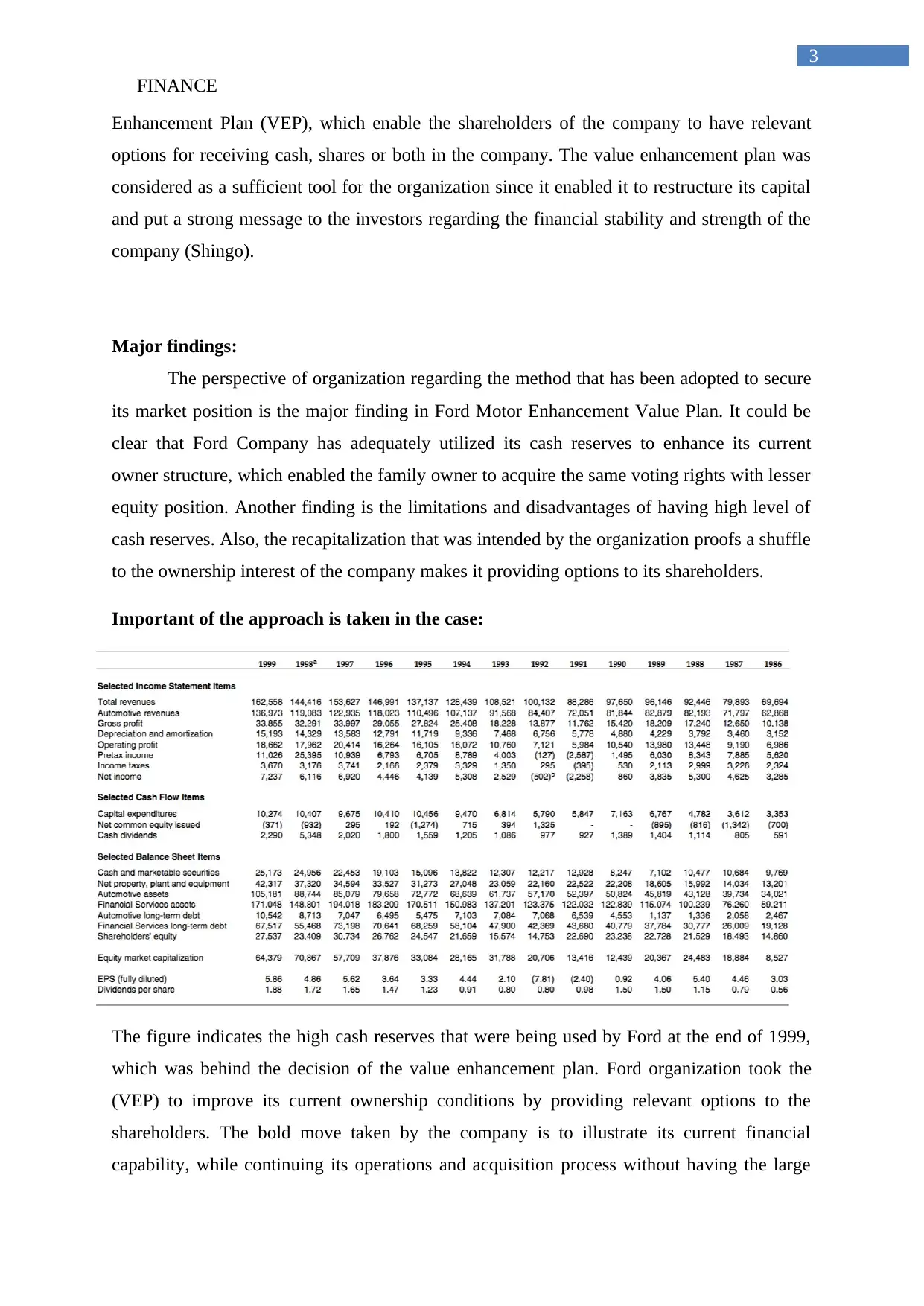
FINANCE
3
Enhancement Plan (VEP), which enable the shareholders of the company to have relevant
options for receiving cash, shares or both in the company. The value enhancement plan was
considered as a sufficient tool for the organization since it enabled it to restructure its capital
and put a strong message to the investors regarding the financial stability and strength of the
company (Shingo).
Major findings:
The perspective of organization regarding the method that has been adopted to secure
its market position is the major finding in Ford Motor Enhancement Value Plan. It could be
clear that Ford Company has adequately utilized its cash reserves to enhance its current
owner structure, which enabled the family owner to acquire the same voting rights with lesser
equity position. Another finding is the limitations and disadvantages of having high level of
cash reserves. Also, the recapitalization that was intended by the organization proofs a shuffle
to the ownership interest of the company makes it providing options to its shareholders.
Important of the approach is taken in the case:
The figure indicates the high cash reserves that were being used by Ford at the end of 1999,
which was behind the decision of the value enhancement plan. Ford organization took the
(VEP) to improve its current ownership conditions by providing relevant options to the
shareholders. The bold move taken by the company is to illustrate its current financial
capability, while continuing its operations and acquisition process without having the large
3
Enhancement Plan (VEP), which enable the shareholders of the company to have relevant
options for receiving cash, shares or both in the company. The value enhancement plan was
considered as a sufficient tool for the organization since it enabled it to restructure its capital
and put a strong message to the investors regarding the financial stability and strength of the
company (Shingo).
Major findings:
The perspective of organization regarding the method that has been adopted to secure
its market position is the major finding in Ford Motor Enhancement Value Plan. It could be
clear that Ford Company has adequately utilized its cash reserves to enhance its current
owner structure, which enabled the family owner to acquire the same voting rights with lesser
equity position. Another finding is the limitations and disadvantages of having high level of
cash reserves. Also, the recapitalization that was intended by the organization proofs a shuffle
to the ownership interest of the company makes it providing options to its shareholders.
Important of the approach is taken in the case:
The figure indicates the high cash reserves that were being used by Ford at the end of 1999,
which was behind the decision of the value enhancement plan. Ford organization took the
(VEP) to improve its current ownership conditions by providing relevant options to the
shareholders. The bold move taken by the company is to illustrate its current financial
capability, while continuing its operations and acquisition process without having the large
Paraphrase This Document
Need a fresh take? Get an instant paraphrase of this document with our AI Paraphraser
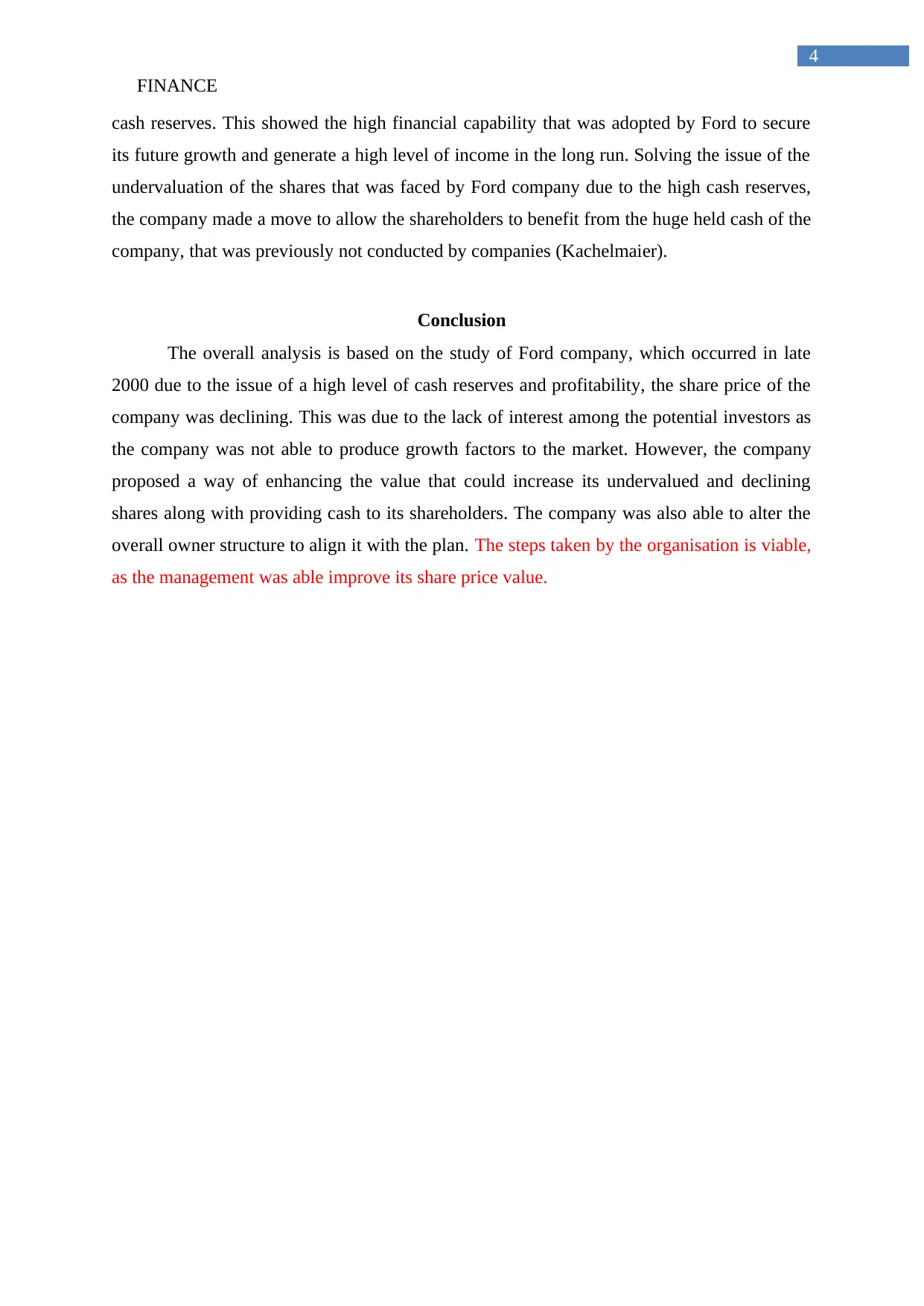
FINANCE
4
cash reserves. This showed the high financial capability that was adopted by Ford to secure
its future growth and generate a high level of income in the long run. Solving the issue of the
undervaluation of the shares that was faced by Ford company due to the high cash reserves,
the company made a move to allow the shareholders to benefit from the huge held cash of the
company, that was previously not conducted by companies (Kachelmaier).
Conclusion
The overall analysis is based on the study of Ford company, which occurred in late
2000 due to the issue of a high level of cash reserves and profitability, the share price of the
company was declining. This was due to the lack of interest among the potential investors as
the company was not able to produce growth factors to the market. However, the company
proposed a way of enhancing the value that could increase its undervalued and declining
shares along with providing cash to its shareholders. The company was also able to alter the
overall owner structure to align it with the plan. The steps taken by the organisation is viable,
as the management was able improve its share price value.
4
cash reserves. This showed the high financial capability that was adopted by Ford to secure
its future growth and generate a high level of income in the long run. Solving the issue of the
undervaluation of the shares that was faced by Ford company due to the high cash reserves,
the company made a move to allow the shareholders to benefit from the huge held cash of the
company, that was previously not conducted by companies (Kachelmaier).
Conclusion
The overall analysis is based on the study of Ford company, which occurred in late
2000 due to the issue of a high level of cash reserves and profitability, the share price of the
company was declining. This was due to the lack of interest among the potential investors as
the company was not able to produce growth factors to the market. However, the company
proposed a way of enhancing the value that could increase its undervalued and declining
shares along with providing cash to its shareholders. The company was also able to alter the
overall owner structure to align it with the plan. The steps taken by the organisation is viable,
as the management was able improve its share price value.
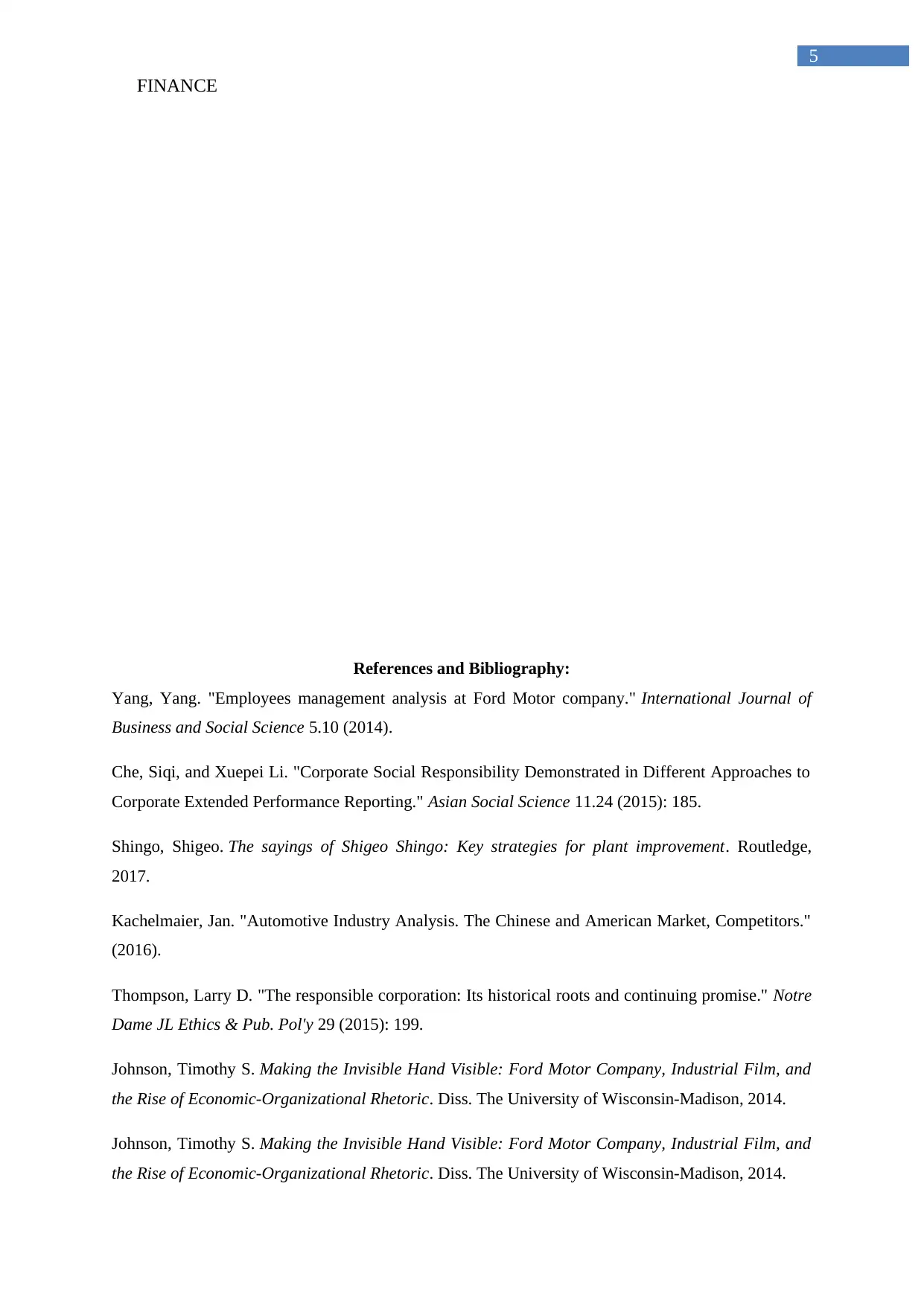
FINANCE
5
References and Bibliography:
Yang, Yang. "Employees management analysis at Ford Motor company." International Journal of
Business and Social Science 5.10 (2014).
Che, Siqi, and Xuepei Li. "Corporate Social Responsibility Demonstrated in Different Approaches to
Corporate Extended Performance Reporting." Asian Social Science 11.24 (2015): 185.
Shingo, Shigeo. The sayings of Shigeo Shingo: Key strategies for plant improvement. Routledge,
2017.
Kachelmaier, Jan. "Automotive Industry Analysis. The Chinese and American Market, Competitors."
(2016).
Thompson, Larry D. "The responsible corporation: Its historical roots and continuing promise." Notre
Dame JL Ethics & Pub. Pol'y 29 (2015): 199.
Johnson, Timothy S. Making the Invisible Hand Visible: Ford Motor Company, Industrial Film, and
the Rise of Economic-Organizational Rhetoric. Diss. The University of Wisconsin-Madison, 2014.
Johnson, Timothy S. Making the Invisible Hand Visible: Ford Motor Company, Industrial Film, and
the Rise of Economic-Organizational Rhetoric. Diss. The University of Wisconsin-Madison, 2014.
5
References and Bibliography:
Yang, Yang. "Employees management analysis at Ford Motor company." International Journal of
Business and Social Science 5.10 (2014).
Che, Siqi, and Xuepei Li. "Corporate Social Responsibility Demonstrated in Different Approaches to
Corporate Extended Performance Reporting." Asian Social Science 11.24 (2015): 185.
Shingo, Shigeo. The sayings of Shigeo Shingo: Key strategies for plant improvement. Routledge,
2017.
Kachelmaier, Jan. "Automotive Industry Analysis. The Chinese and American Market, Competitors."
(2016).
Thompson, Larry D. "The responsible corporation: Its historical roots and continuing promise." Notre
Dame JL Ethics & Pub. Pol'y 29 (2015): 199.
Johnson, Timothy S. Making the Invisible Hand Visible: Ford Motor Company, Industrial Film, and
the Rise of Economic-Organizational Rhetoric. Diss. The University of Wisconsin-Madison, 2014.
Johnson, Timothy S. Making the Invisible Hand Visible: Ford Motor Company, Industrial Film, and
the Rise of Economic-Organizational Rhetoric. Diss. The University of Wisconsin-Madison, 2014.
⊘ This is a preview!⊘
Do you want full access?
Subscribe today to unlock all pages.

Trusted by 1+ million students worldwide
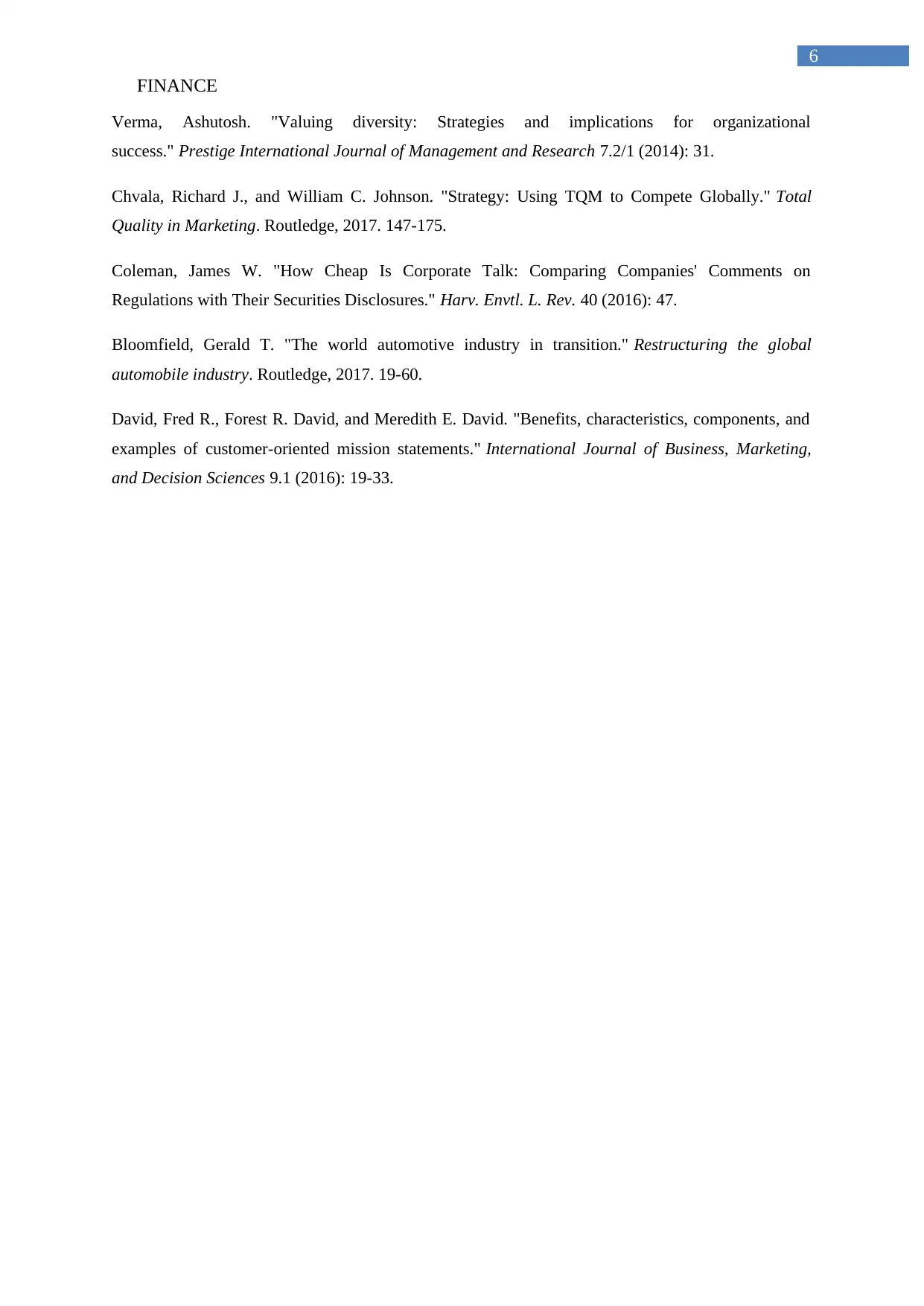
FINANCE
6
Verma, Ashutosh. "Valuing diversity: Strategies and implications for organizational
success." Prestige International Journal of Management and Research 7.2/1 (2014): 31.
Chvala, Richard J., and William C. Johnson. "Strategy: Using TQM to Compete Globally." Total
Quality in Marketing. Routledge, 2017. 147-175.
Coleman, James W. "How Cheap Is Corporate Talk: Comparing Companies' Comments on
Regulations with Their Securities Disclosures." Harv. Envtl. L. Rev. 40 (2016): 47.
Bloomfield, Gerald T. "The world automotive industry in transition." Restructuring the global
automobile industry. Routledge, 2017. 19-60.
David, Fred R., Forest R. David, and Meredith E. David. "Benefits, characteristics, components, and
examples of customer-oriented mission statements." International Journal of Business, Marketing,
and Decision Sciences 9.1 (2016): 19-33.
6
Verma, Ashutosh. "Valuing diversity: Strategies and implications for organizational
success." Prestige International Journal of Management and Research 7.2/1 (2014): 31.
Chvala, Richard J., and William C. Johnson. "Strategy: Using TQM to Compete Globally." Total
Quality in Marketing. Routledge, 2017. 147-175.
Coleman, James W. "How Cheap Is Corporate Talk: Comparing Companies' Comments on
Regulations with Their Securities Disclosures." Harv. Envtl. L. Rev. 40 (2016): 47.
Bloomfield, Gerald T. "The world automotive industry in transition." Restructuring the global
automobile industry. Routledge, 2017. 19-60.
David, Fred R., Forest R. David, and Meredith E. David. "Benefits, characteristics, components, and
examples of customer-oriented mission statements." International Journal of Business, Marketing,
and Decision Sciences 9.1 (2016): 19-33.
1 out of 7
Related Documents
Your All-in-One AI-Powered Toolkit for Academic Success.
+13062052269
info@desklib.com
Available 24*7 on WhatsApp / Email
![[object Object]](/_next/static/media/star-bottom.7253800d.svg)
Unlock your academic potential
Copyright © 2020–2025 A2Z Services. All Rights Reserved. Developed and managed by ZUCOL.




